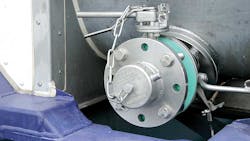MOST people don’t give it much thought, but in reality, a bolted-flange connection is a complex multi- component system that involves flanges, bolts, and gaskets, according to Tom Lokey, bulk equipment specialist for VSP Technologies.
“For a reliable connection, you need a balance of force,” he said during the Tank Truck Week Maintenance Track. “There are negative forces. Think about fluid going through and pressure trying to push out of that connection. And then you have a positive force, which is the bolt tension or fasteners. All those things are working for and against each other to make a reliable connection.”
He said a bolted-flange joint consists of a flange; fasteners; and gasket material, which involves chemical compatibility, mechanical requirements, and assembly considerations (assuming controlled procedures are in use).
How does a gasket work? A gasket is softer than flanges. It flows when compressed into flange imperfections. Gasket material determines required flange load.
According to a study by the Pressure Vessel Research Center, here are the sealing system reasons for a gasket leak: improper installation, 26%; damaged flange, 25%; defective gasket, 22%; loose bolts, 15%; and flange misalignment, 12%.
“If you have a trained mechanic putting these components together, he should notice flange damage,” Lokey said. “Mechanics properly trained should not be misaligning these flanges. A majority of this can reflect right back to the mechanic.”
He said that with gasket creep/cold flow, gasket stress decreases, there is a loss of fastener pre-load, and fasteners are more susceptible to vibration loosening.
Ideally, it is preferable to choose a material that does not relax.
“Gaskets and gasket materials are application-specific,” he said. “Not every gasket material is right for every application. You have to think about what you’re shipping and what your connection and fasteners look like, and that’s how you make a determination of what your gasket material is. You can’t use a rubber gasket for everything. I mean, you can, but you’re going to have disastrous results.”
Common gasket materials and failure modes:
• Elastomers: chemical compatibility, aging, over-compression, torque loss.
• Compressed non-asbestos fiber: thermal degradation, under-compression, chemical compatibility.
• Polytetrafluoroethylene (a.k.a. “teflon”): chemical compatibility (filled), torque loss, over-compression.
• Flexible graphite: oxidation, breakage/handling damage, process contamination.
• Teflon envelope: exhibits properties of both non-asbestos fiber and Teflon.
He said an improper tightening of bolts can cause flange damage and costly repairs.
A basic understanding of fastener specification involves:
• Tensile strength: The maximum stress in tension (pulling apart) that a material can withstand before breaking or fracturing.
• Yield strength: The maximum stress at which a material exhibits a specific permanent deformation.
Proper flange assembly:
• Lubricate all threads and nut-bearing surfaces with Jet-Lube.
• Run all nuts down snug (finger tight).
• Using a calibrated torque wrench, tighten bolts in a star/criss-cross pattern sequence, in a minimum of three passes, increasing bolt load/torque after every pass.
• Finish with at least one clockwise rotational pass to ensure all bolts are to maximum torque.
• Inspect the sealing surface.
• Clean and prep the sealing surface.
• Have the correct design information.
• Inspect the flange alignment.
• Inspect the fasteners.
• Properly install the gasket and fasteners.
• Properly tighten the fasteners.
• Quality check and record installation data for critical services.
“If any step is missing, the joint is subject to leaks,” he said. ♦
About the Author
Rick Weber
Associate Editor
Rick Weber has been an associate editor for Trailer/Body Builders since February 2000. A national award-winning sportswriter, he covered the Miami Dolphins for the Fort Myers News-Press following service with publications in California and Australia. He is a graduate of Penn State University.

